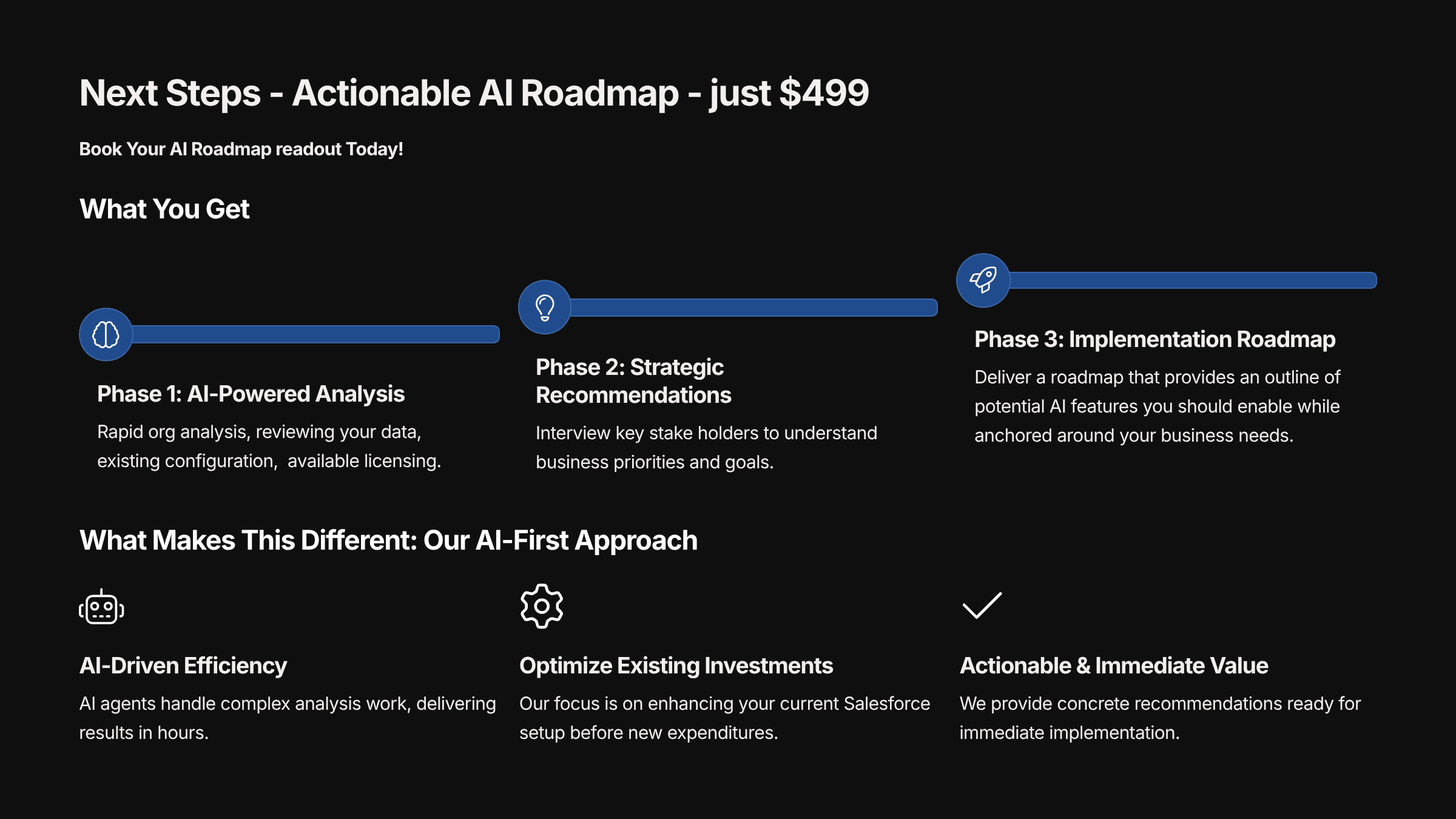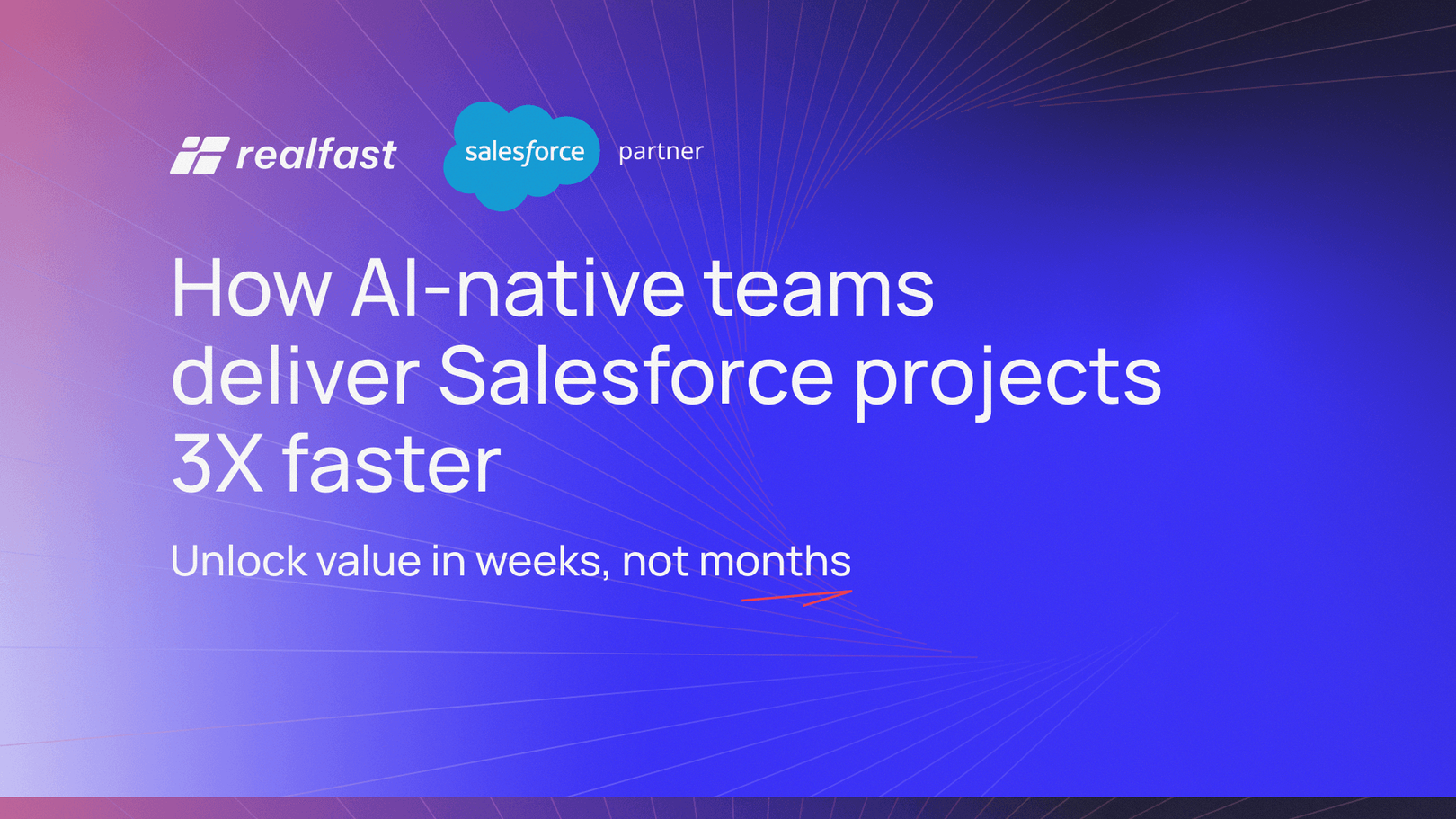Originally published following our webinar on AI-first delivery featuring Heather Mao (Strategic Account Director, Agentforce Salesforce), Sidu Ponnappa (CEO, realfast), Aakash Dharmadhikari (CPTO & Co-founder, realfast), and Paulomi Gudka (Managing Director, realfast USA)
Traditional IT delivery is colliding with AI-speed expectations.
While everyone talks transformation, most organizations remain trapped in the same patterns that have plagued implementations for years - dragging timelines, exploding budgets, solutions that miss requirements.
Our recent webinar revealed something different: what happens when you fundamentally rethink Salesforce delivery for an AI-first world. The conversation wasn’t just about using AI tools - it was about becoming an AI-native organization.
“I’ve seen these projects take forever and drag on because some missed requirement,” explained Paulomi Gudka, Managing Director of realfast USA. “All of these things have been symptoms of a challenge that we can now see ourselves being able to solve using AI.”
The problem: traditional IT meets AI urgency
Organizations face a perfect storm. The same systemic issues persist - knowledge concentrated in 1-2 people creating emergency situations, long sprints that deliver nothing until the end, projects that spiral beyond original scope. But now there’s new pressure layered on top.
Competitors are implementing AI workflows at unprecedented speed. The fear of being left behind is driving hasty decisions. Yet the concerns remain real - hallucination risks, team disruption, implementation costs that spiral out of control.
This creates a fundamental gap: traditional delivery methods simply cannot handle AI-speed expectations, but everyone wants AI integrated into their workflows anyway.
Start with what you already own
The biggest revelation came from Heather Mao at Salesforce, who cut through the hype with practical advice that most organizations completely miss.
“You already have AI capabilities within your ecosystem. Things like case classification, knowledge recommendations, opportunity scoring, and lead scoring. All of this can be quick wins available to you.”
Think about this for a moment. Most Salesforce customers are already paying for AI features they’re not using. The rush to buy new licenses often ignores the untapped potential sitting right there in existing investments.
Heather’s methodology makes strategic sense: “Our advice is really to start with what you already have. Most of you are already Salesforce customers with Service Cloud, Sales Cloud Platform. You already have AI capabilities.” emphasized Heather Mao, Strategic Account Director, Agentforce, Salesforce.
The crawl, walk, run approach means activating existing features first, optimizing what needs fine-tuning, then scaling based on proven success. It’s about building confidence through quick wins rather than betting everything on moonshot implementations.
“Really to start with what you already have” isn’t just practical advice - it’s risk management. When you can demonstrate AI value using existing licenses, stakeholder buy-in for larger investments becomes much easier.
What AI-first delivery actually looks like
Here’s where traditional system integrators reveal their limitations. They talk about AI transformation while operating with human-speed processes. The disconnect is obvious once you see it.
True AI-first delivery operates differently. At realfast, every team member works with AI augmentation. Project managers don’t manually track meetings - AI captures action items automatically. Business analysts don’t spend days writing requirements - they generate documentation at machine speed. Developers don’t code alone - they orchestrate AI to handle repetitive work while focusing on complex problem-solving.
“3X faster delivery isn’t a promise - it’s our new minimum standard,” explained Aakash Dharmadhikari, our CPTO. “Every team member is AI-augmented, from project managers to QA engineers.”
This isn’t about replacing humans. It’s about buying back expensive developer hours at a fraction of the cost. When routine tasks happen at AI speed, human expertise gets redirected to work that actually moves the needle.
The hallmarks become visible quickly: substantially faster turnaround times on every deliverable, transparent processes where AI handles documentation overhead automatically, and robust solutions that work in production from day one rather than requiring extensive debugging cycles.
Results that break expectations
We’re consistently delivering outcomes that experienced teams describe as “humanly impossible.” These aren’t marketing claims - they’re measurable results from real client engagements.
A UK personal finance firm needed real-time KYC scoring integrated directly into Salesforce. The scope included LWC development, custom objects, Apex code, test data, and permission sets. Traditionally, this represents weeks of work. We delivered it in 8 hours.
But the most striking example came from Paulomi’s recent experience: “We were given this request on a Friday for a production-ready delivery for the following Friday. Seven days to deliver an AgentForce agent.”
The complexity made this particularly challenging. The agent needed to deliver information with citations - not standard Salesforce functionality. Yet the process revealed how AI-first delivery fundamentally changes project dynamics.
“Every day, we were doing demo cycles. Over 24 hours, we were able to build, show it to customers, validate, verify, and build again.” Traditional sprint cycles compressed from weeks into daily iterations.
The real breakthrough happened in testing: “We tested over 2,000 scenarios in less than 24 hours. This is not possible unless every step of the way, you’re introducing AI into the process. It’s not humanly possible otherwise.”
Consider what this means for project risk. Instead of waiting weeks to discover issues during UAT, problems surface and get resolved within hours. The client gains confidence through transparency rather than hoping everything works during the final reveal.
The testing revolution: why manual QA fails with AI
The most critical insight from our discussion addresses a fundamental challenge that most organizations haven’t grasped yet: you cannot test AI systems using traditional manual approaches.
“Except for a very small set of scenarios, you cannot test AI manually. AI must be tested by AI - that’s the only way this works,” emphasized Sidu, CEO and Co-founder of realfast during the session.
This isn’t a technical detail - it’s a business reality. AI agents can handle thousands of conversation paths, each potentially different based on context. Manual testing teams, even with significant resources, cannot validate this complexity within reasonable timelines.
Traditional QA approaches that work for deterministic systems collapse when applied to AI agents. The variability is too high, the interaction patterns too complex, the edge cases too numerous for human testing to provide meaningful coverage.
Our automated testing framework operates differently. It validates response quality across thousands of scenarios simultaneously, catches engagement problems before they reach production, and monitors accuracy continuously. This gives clients confidence to deploy agents handling their highest-value leads and most critical customer interactions.
For organizations considering AI implementation, this testing capability often becomes the deciding factor. It’s the difference between prototype demos that impress stakeholders and production systems that reliably handle business-critical workflows.
Roadmaps that drive decisions
Unlike traditional consulting assessments that generate beautiful documents and little action, our AI roadmap process focuses on immediate implementability.
Aakash highlighted the key difference: “We are not giving a roadmap of features that can be enabled, or some basic implementations that you see in a marketing narrative. Marketing narratives don’t know your business realities.”
The approach combines three critical inputs: deep analysis of your Salesforce org configuration and data quality, understanding of your existing business processes and pain points, and evaluation of current licensing and feature utilization.
This creates something most roadmaps lack - specific business problems matched with AI solutions that can be implemented immediately, complete with delivery timelines and expected impact validated against your actual system complexity.
The output becomes a decision-making tool rather than a planning document. Leadership can see exactly which AI implementations will deliver value quickly and which require longer-term investment.
Speed drives everything else
The economic reality underlying all of this is simple: in enterprise software, speed trumps cost optimization almost every time.
Every day a new system isn’t in production represents opportunity cost. While CFOs negotiate budget details, end users and business owners are measuring time-to-value. A project that comes in on budget but ships a month late frustrates the stakeholders who need to show results.
This creates the fundamental tailwind for AI adoption in IT services. When you can deliver in half the time while maintaining quality, you’re not just offering efficiency - you’re reducing risk for everyone involved.
Clients get to validate approaches quickly rather than waiting months to discover what works. Teams can iterate based on real feedback instead of theoretical requirements. Projects build momentum through visible progress rather than losing energy through extended development cycles.
The compounding effects become obvious once you experience them. Faster delivery leads to earlier feedback, which enables better solutions, which creates more stakeholder confidence, which funds additional AI initiatives.
What this means for your organization
The shift to AI-first delivery isn’t just about technology adoption - it’s about competitive positioning. Organizations that can deliver Salesforce solutions in weeks rather than months will win business that slower competitors can’t even bid for effectively.
The technical capabilities exist today. Most Salesforce instances already contain AI features that remain unactivated. The foundational models can handle complex analysis and code generation reliably. The integration tools can orchestrate workflows that previously required extensive manual coordination.
What’s missing is the operational discipline to leverage these capabilities systematically rather than experimentally. This requires teams that understand both AI tooling and Salesforce complexity, processes designed for AI-speed iteration, and testing frameworks that can validate AI outputs at scale.
Getting started
For organizations ready to experience this difference, we’re offering AI roadmap assessments for $499 that identify immediate opportunities within your existing Salesforce investment. Unlike traditional consulting documents, this uses our AI-first methodology to deliver analysis in hours rather than weeks, focusing on AI capabilities you can activate immediately using licenses you already own.

Ready to experience AI-first delivery?
Get your personalized AI roadmap for $499: realfast.ai/contact
The question isn’t whether AI will transform Salesforce delivery - it’s whether you’ll be leading that transformation or reacting to competitors who moved first.

